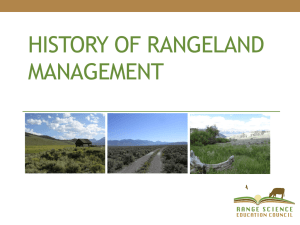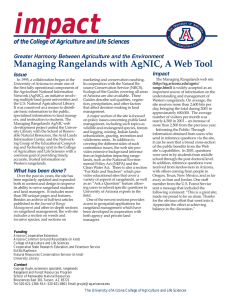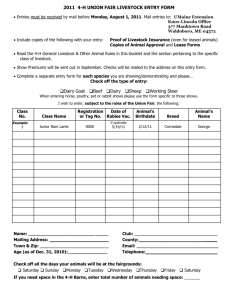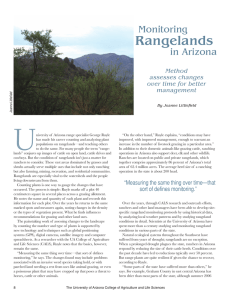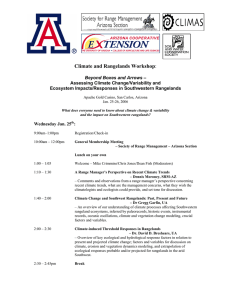SUSTAINABLE RANCHING
advertisement
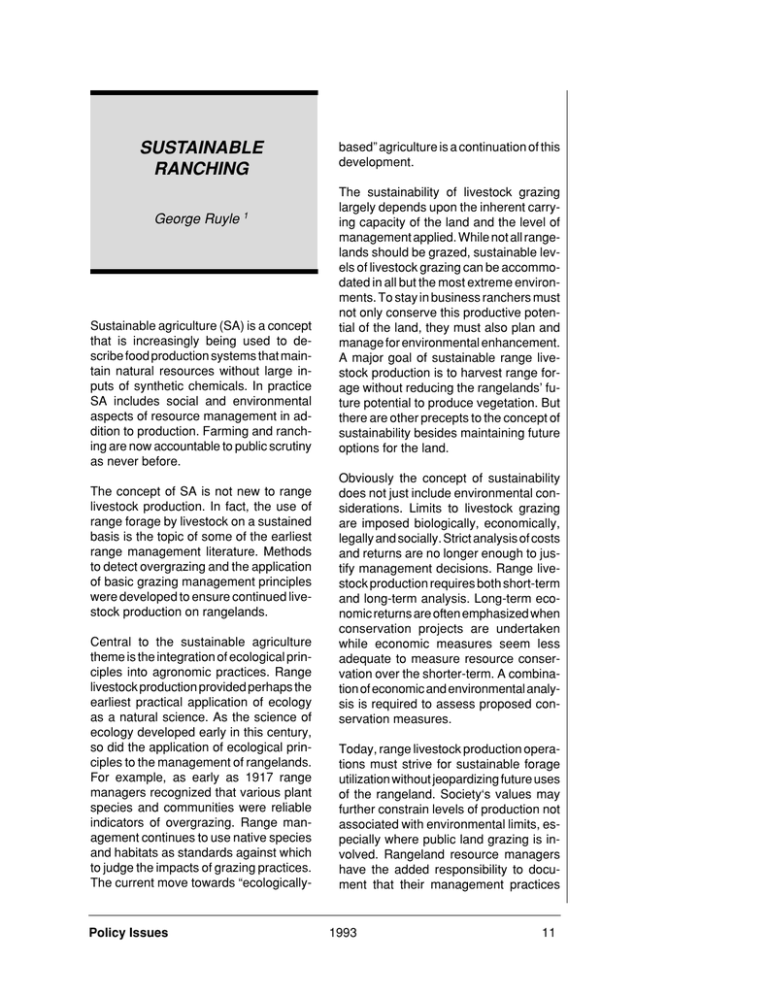
SUSTAINABLE RANCHING George Ruyle 1 Sustainable agriculture (SA) is a concept that is increasingly being used to describe food production systems that maintain natural resources without large inputs of synthetic chemicals. In practice SA includes social and environmental aspects of resource management in addition to production. Farming and ranching are now accountable to public scrutiny as never before. The concept of SA is not new to range livestock production. In fact, the use of range forage by livestock on a sustained basis is the topic of some of the earliest range management literature. Methods to detect overgrazing and the application of basic grazing management principles were developed to ensure continued livestock production on rangelands. Central to the sustainable agriculture theme is the integration of ecological principles into agronomic practices. Range livestock production provided perhaps the earliest practical application of ecology as a natural science. As the science of ecology developed early in this century, so did the application of ecological principles to the management of rangelands. For example, as early as 1917 range managers recognized that various plant species and communities were reliable indicators of overgrazing. Range management continues to use native species and habitats as standards against which to judge the impacts of grazing practices. The current move towards “ecologically- Policy Issues based” agriculture is a continuation of this development. The sustainability of livestock grazing largely depends upon the inherent carrying capacity of the land and the level of management applied. While not all rangelands should be grazed, sustainable levels of livestock grazing can be accommodated in all but the most extreme environments. To stay in business ranchers must not only conserve this productive potential of the land, they must also plan and manage for environmental enhancement. A major goal of sustainable range livestock production is to harvest range forage without reducing the rangelands’ future potential to produce vegetation. But there are other precepts to the concept of sustainability besides maintaining future options for the land. Obviously the concept of sustainability does not just include environmental considerations. Limits to livestock grazing are imposed biologically, economically, legally and socially. Strict analysis of costs and returns are no longer enough to justify management decisions. Range livestock production requires both short-term and long-term analysis. Long-term economic returns are often emphasized when conservation projects are undertaken while economic measures seem less adequate to measure resource conservation over the shorter-term. A combination of economic and environmental analysis is required to assess proposed conservation measures. Today, range livestock production operations must strive for sustainable forage utilization without jeopardizing future uses of the rangeland. Society‘s values may further constrain levels of production not associated with environmental limits, especially where public land grazing is involved. Rangeland resource managers have the added responsibility to document that their management practices 1993 11 indeed meet all of the demands that sustainability implies. Current approaches to developing indexes of sustainability for a variety of rangeland uses are focusing on soil protection as the characteristic most directly related to maintaining potential site productivity. Accelerated soil erosion is as old as agriculture itself and continues to be a major problem today. Vegetation will nevertheless continue to be a major indicator of rangeland conditions and therefore part of the index to whether or not current uses are sustainable. Particular plant communities may not be as important to future potentials as they are to current uses. However, plant communities are not static. They change with climate, species availability and other factors. Additionally, management practices will not always control vegetation change. While some simplistically believe that only complete removal of livestock will correct past damage from overgrazing, rangelands will not necessarily return to previous conditions simply by alleviating livestock grazing. The SA approach to range livestock production involves meeting future objectives which may or may not relate to past vegetation types. The demands placed on rangelands are also changing resulting in changing demands for products and values. Maintaining a particular vegetation may not be feasible or desirable over the long-term, but maintaining the productive potential of the land is. To ranchers and other land managers who serve as natural resource stewards, sustainability is often an implicit responsibility. But the public needs to become more aware of the processes that lead to sustainable uses of rangelands. Sustainable range livestock production is achieved through the thoughtful application of science and experience and documented through monitoring resource values and production levels. The idea of sustainable ranching may serve as a rallying point for forward-thinking natural resource planning and management rather than the popular focus on past abuses. As Dr. Neil West of Utah State University recently wrote “the bigger issue is protecting the ability of the land to produce into the future.” Ranching practices that consider broad environmental and community issues are basic to the concept of sustainable agriculture. Department of Natural Resources Specialist 1 College of Agriculture The University of Arizona Tucson, Arizona 85721 Policy Issues 1993 12 FROM: Arizona Ranchers' Management Guide Russell Gum, George Ruyle, and Richard Rice, Editors. Arizona Cooperative Extension Disclaimer Neither the issuing individual, originating unit, Arizona Cooperative Extension, nor the Arizona Board of Regents warrant or guarantee the use or results of this publication issued by Arizona Cooperative Extension and its cooperating Departments and Offices. Any products, services, or organizations that are mentioned, shown, or indirectly implied in this publication do not imply endorsement by The University of Arizona. Issued in furtherance of Cooperative Extension work, acts of May 8 and June 30, 1914, in cooperation with the U.S. Department of Agriculture, James Christenson, Director, Cooperative Extension, College of Agriculture, The University of Arizona. The University of Arizona College of Agriculture is an Equal Opportunity employer authorized to provide research, educational information and other services only to individuals and institutions that function without regard to sex, race, religion, color, national origin, age, Vietnam Era Veteran’s status, or handicapping conditions. Policy Issues 1993 13 Policy Issues 1993 14
